A Wader Spectacular tour today. It was a lovely sunny summer’s day, warm with light winds – perfect weather. It was an early start, to get up to the Wash in good time before the tide came in, but it was worth it!
As we arrived up on the seawall, there was still plenty of exposed mud out on the Wash. It was quite a vista – a vast slick of birds was spread across the surface, shining bright in the morning sun.
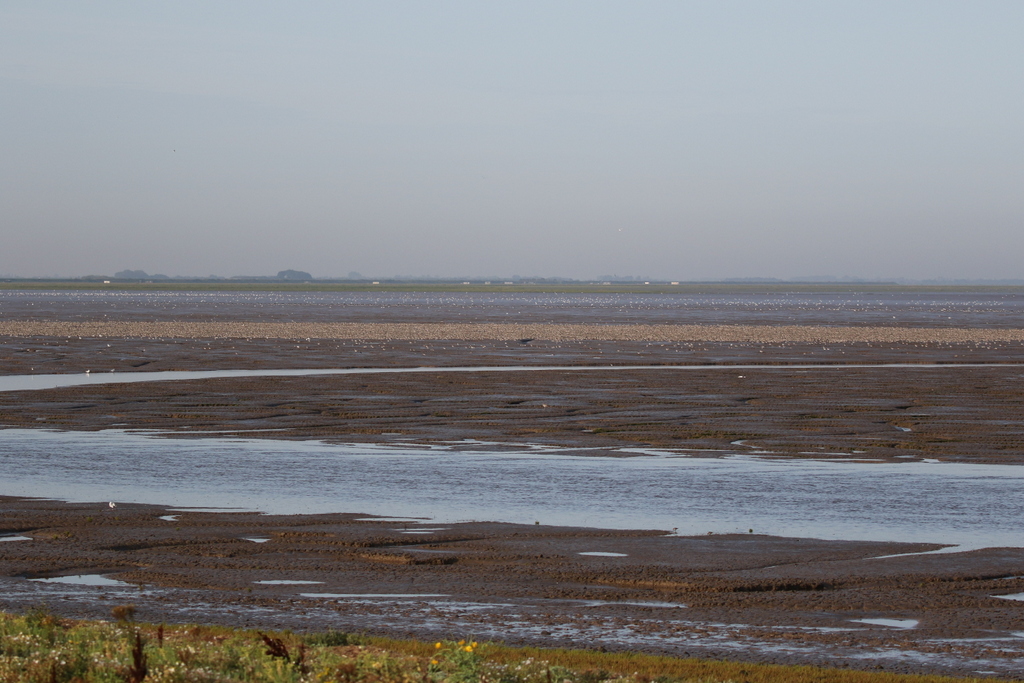 The Wash – with a vast slick of waders in the morning sun
The Wash – with a vast slick of waders in the morning sun
We stopped to watch the birds for a while. The tide was coming in very quickly, and periodically large groups of Knot would fly up ahead of the rising water and land again further up the mud. Just beyond them, the Oystercatchers were walking more methodically away from the tide.
Down at the front, on the nearside of the channel, flocks of smaller waders kept flying in and landing briefly, while others were trying to sleep, Ringed Plover, Dunlin, Sanderling and Turnstone. A lone Knot, a juvenile, was feeding down on the edge of the mud just below the path, giving us a great opportunity to look at one up close, rather than being mesmerised by the thousands further out on the mud.
 Ringed Plover & Dunlin – trying to sleep ahead of the rising tide
Ringed Plover & Dunlin – trying to sleep ahead of the rising tide
Very quickly, the mud in front of where we were standing was covered by the tide, so we made our way further along the seawall. Here we stopped again to take a closer look at the vast flocks of waders. Through the scope, we could see that the Knot were a mixture of colours, many in grey non-breeding or juvenile plumage but a few still in orange breeding plumage.
There were lots of Bar-tailed Godwits too, some of those in rusty summer plumage still, with the red colour extending right down under the tail. A single Black-tailed Godwit down at the front was already in grey winter plumage. A lone Grey Plover appeared, also already in grey non-breeding plumage. There were birds other than waders too. A small group of terns had gathered on the mud ahead of the rising tide, a mixture of Common and Sandwich Terns. A raft of Shelduck was bobbing around on the water.
Then something spooked the Knot and they all took off, thousands upon thousands of them in the air at once. They swirled round, flashing white and dark as they twisted and turned, like a huge wave. It was mesmerising to watch.
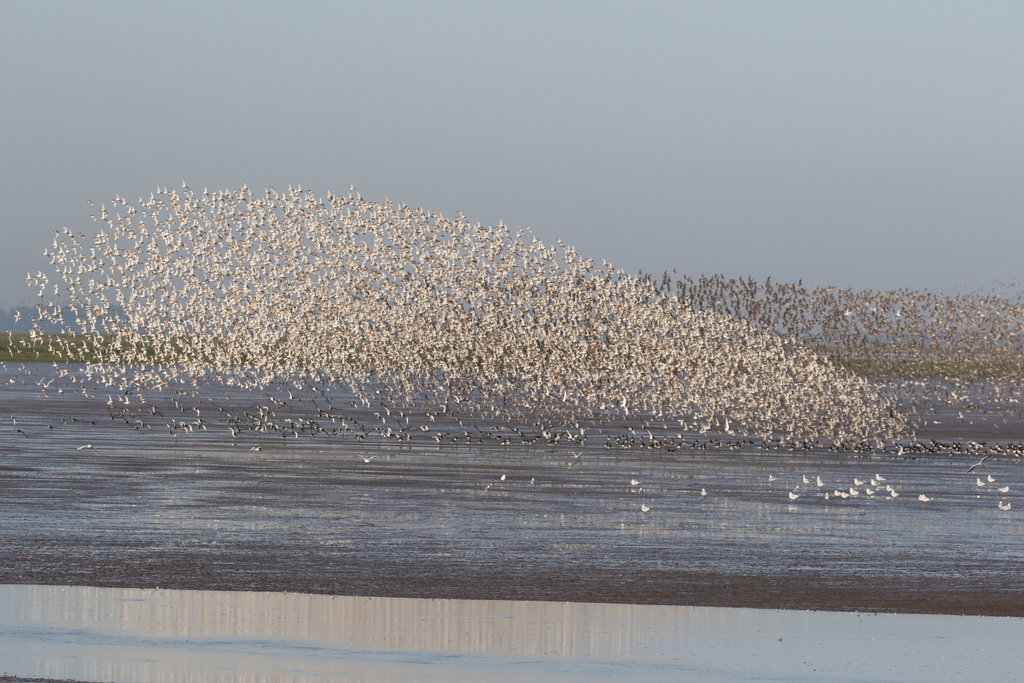
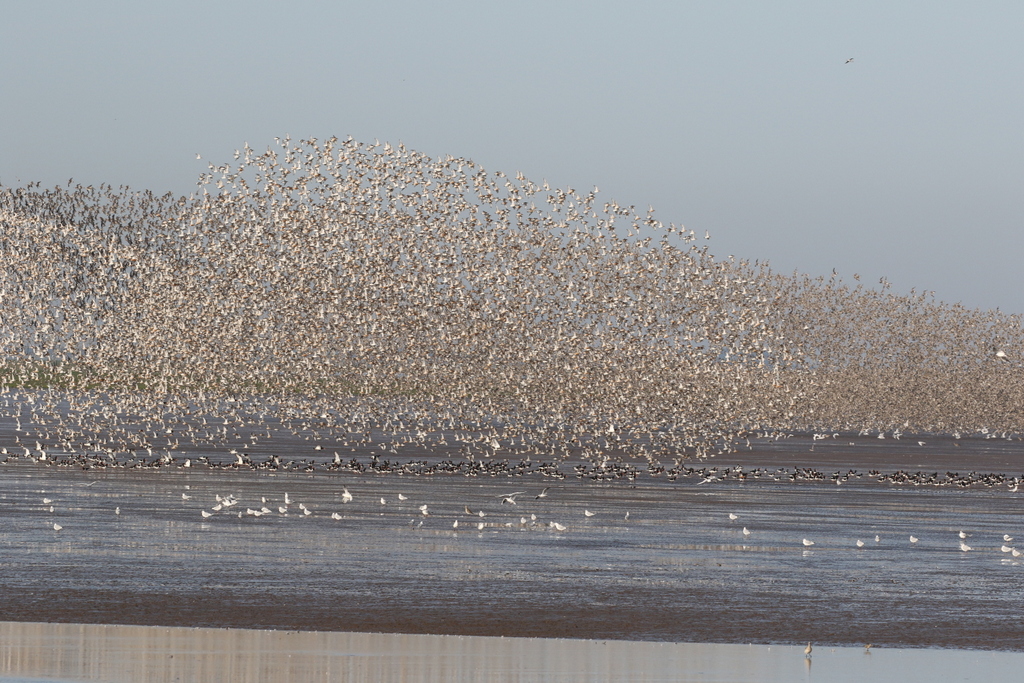
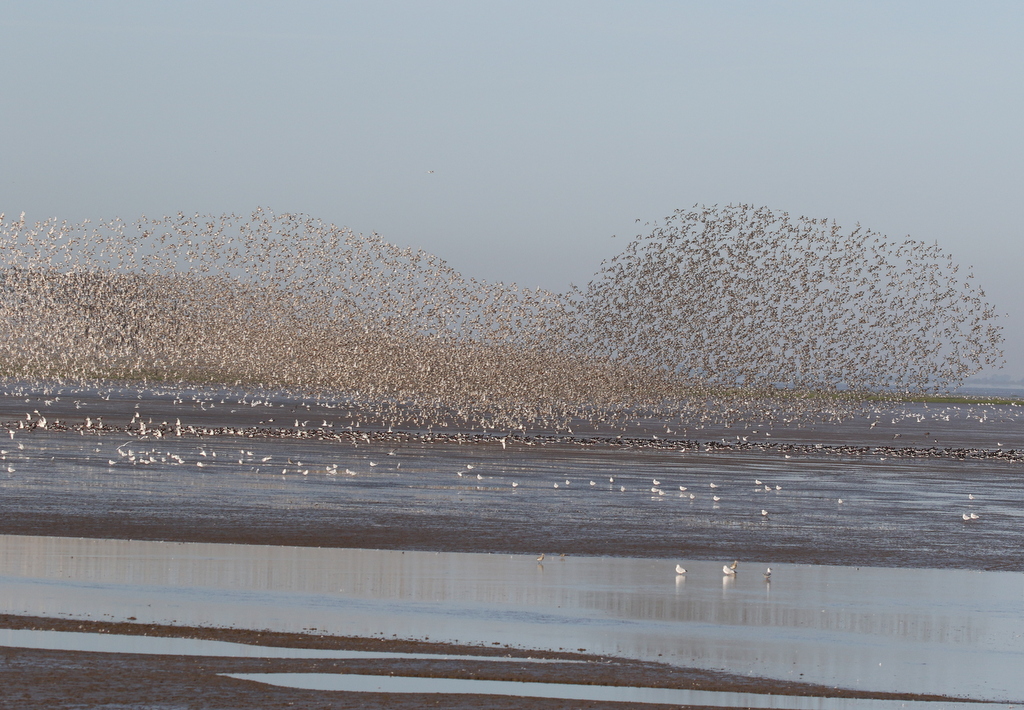
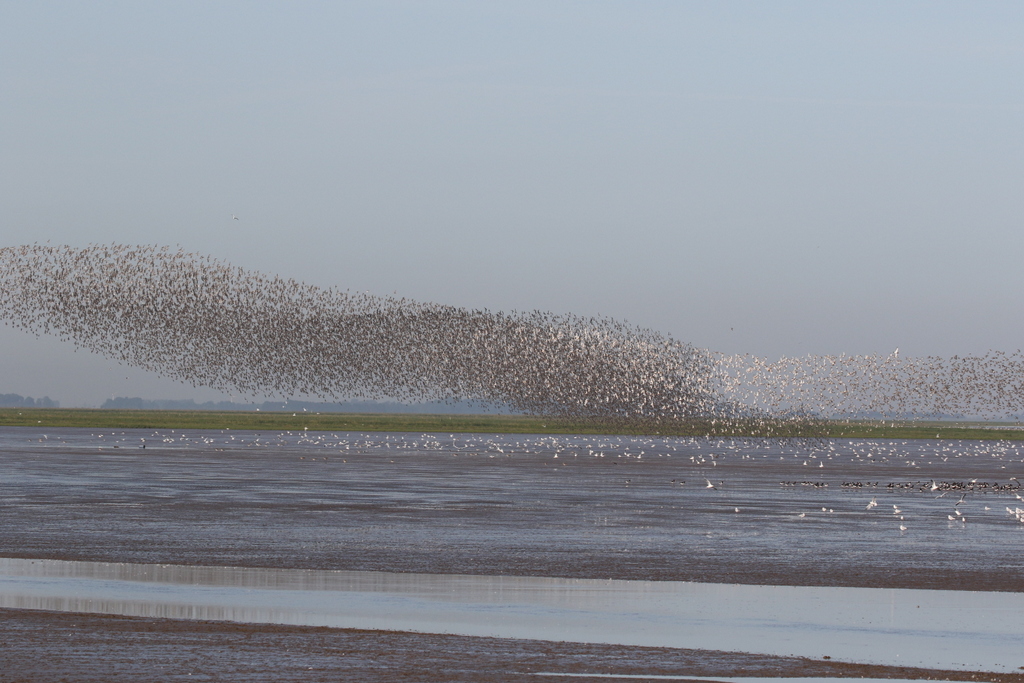 Knot – thousands twisting and turning
Knot – thousands twisting and turning
Eventually the Knot calmed down and started to land again, back down on the mud. As the birds above hung in the air waiting for a landing slot, the sky went dark with a thick cloud of birds.
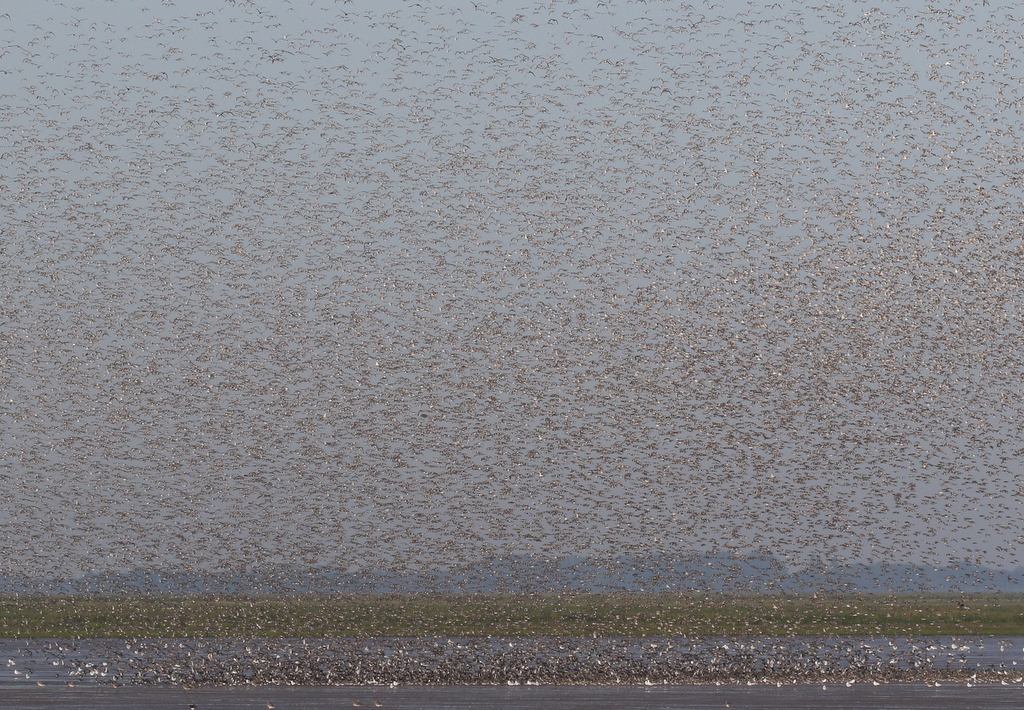 Knot – the vast flock landing again on the mud
Knot – the vast flock landing again on the mud
Some of the waders leave the Wash early, not waiting for the tide to come right in. The Common Redshanks started to fly past us in small groups. A sharpt ‘tchuit’ call alerted us to a Spotted Redshank which came in off the mud and past us in with them. Some small flocks of Dunlin also flew in over the seawall and dropped down to the pit beyond.
We walked further along, down to the corner where the waders were starting to gather in the last mud to be covered by the tide. On the way, a Common Whitethroat was singing in the brambles on the seawall and flicked off ahead of us. A Yellow Wagtail flew over our heads, calling.
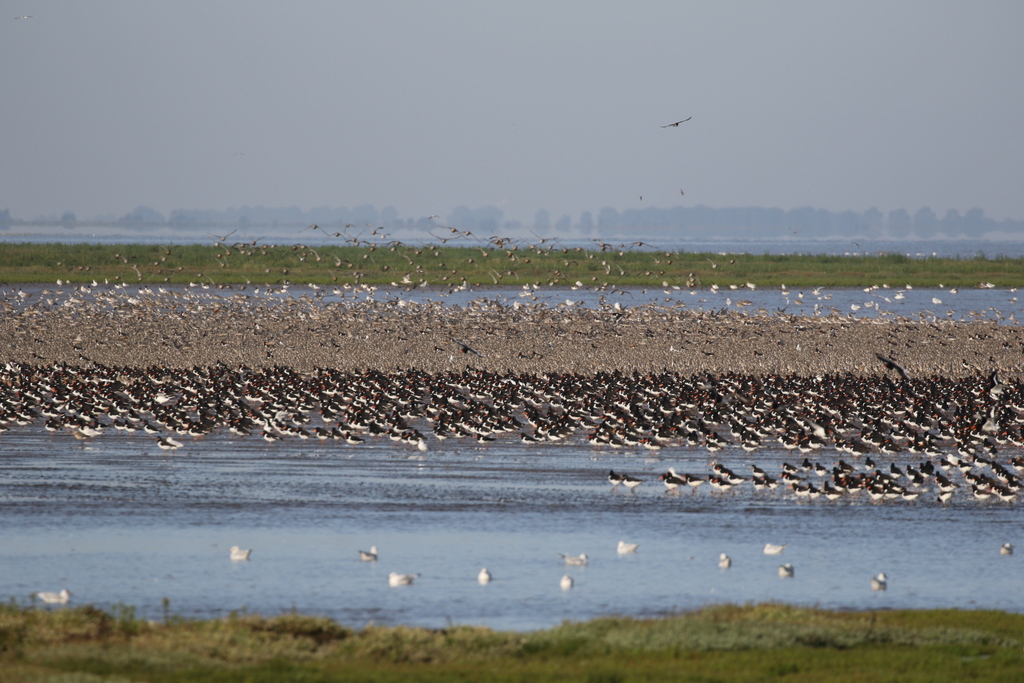 Waders – increasingly concentrated into the last corner of mud
Waders – increasingly concentrated into the last corner of mud
As the water continued to rise quickly, the area of exposed mud progressively shrank and the waders were increasingly concentrated into the last corner. The Oystercatchers started to give up the fight against the tide and peeled off in lines, flying past us piping before circling round and dropping down to the banks of the pit behind us.
We could see that many of the Oystercatchers were moulting, with gaps in their wings visible as they flew over our heads. Many waders come to the Wash to moult at this time of year, feeling safer out on a vast muddy estuary in big flocks, and with plenty of food to fuel the growth of the new feathers.
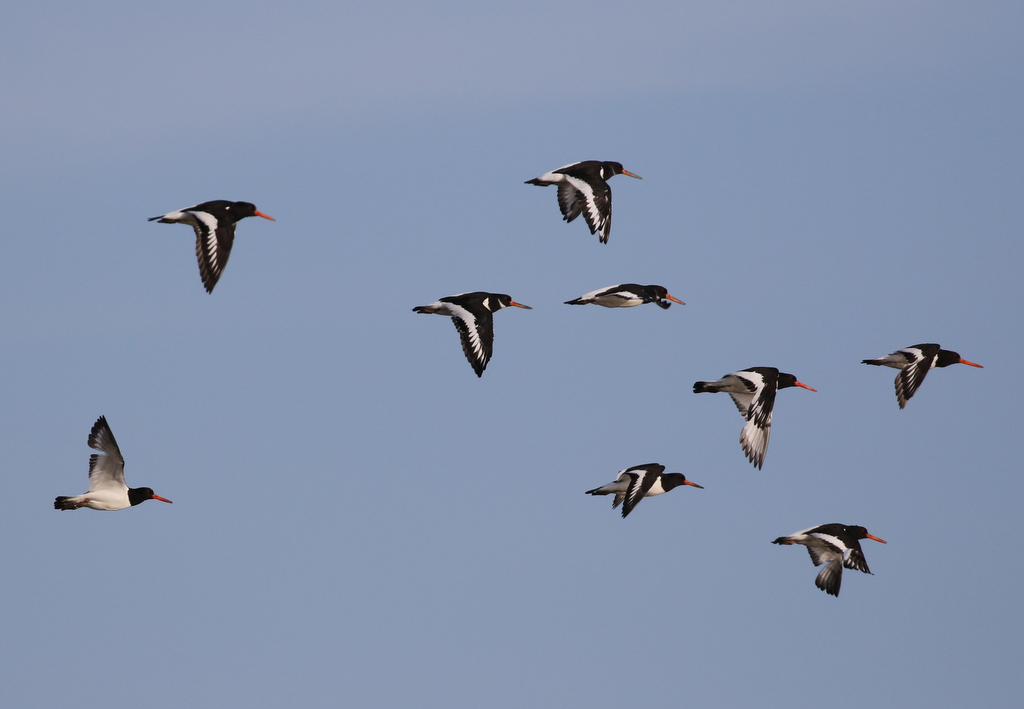 Oystercatchers – the first to leave as the tide covered the remaining mud
Oystercatchers – the first to leave as the tide covered the remaining mud
Finally the Knot started to take off too. They came in several waves today, each tens of thousands of birds strong. As each wave flew in and over our heads, all we could hear was the simultaneous beating of thousands of pairs of wings. An amazing experience.
We watched as the Knot circled over the pits behind us. They couldn’t all land at once, so they split into smaller groups, some swirling high overhead, others flying back out towards the Wash.

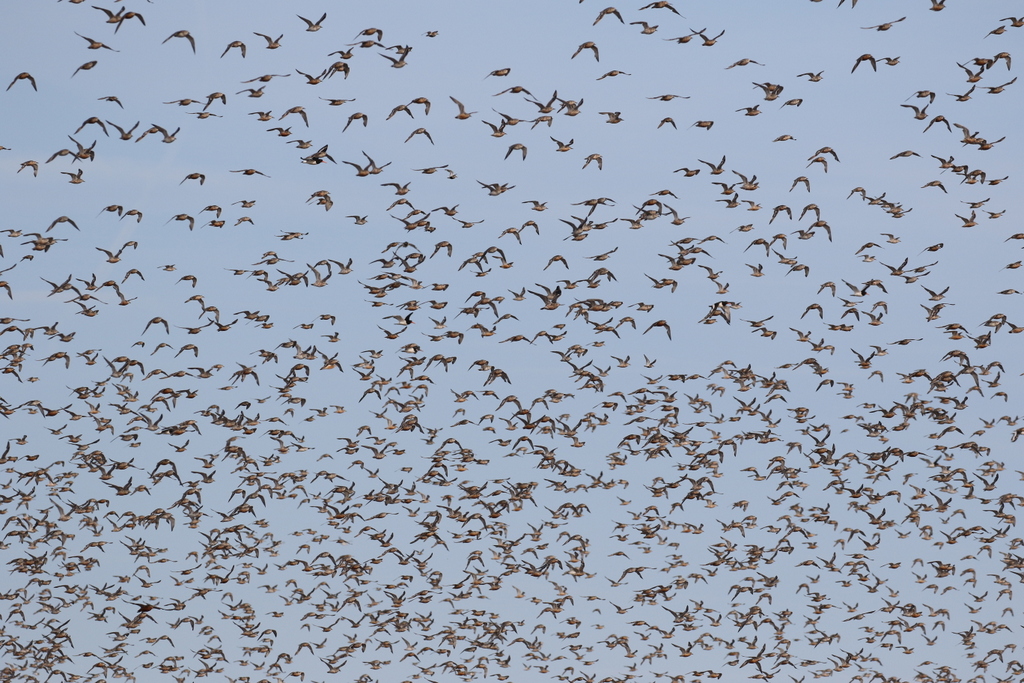 Knot – finally taking off in vast waves & flying in to roost
Knot – finally taking off in vast waves & flying in to roost
Once most of the Knot had left the mud, we turned to walk to Shore Hide. A Common Sandpiper flew past over the water, calling, flicking its bowed wings, and disappeared up along the channel higher into the saltmarsh.
In the hide, the birds were very nervous. The waders normally don’t like the island directly in front of the hide, but the next one over is normally packed with Knot. There were fewer waders on here today. A large group of Knot and Dunlin were shuffling around on one half of it but they were very jumpy, repeatedly taking off and flying round before landing again. Some bigger groups of Knot were packed tightly into a couple of islands further over.
 Knot, Dunlin & Redshank – shuffling nervously on one of the islands
Knot, Dunlin & Redshank – shuffling nervously on one of the islands
Pretty soon, we realised why the birds were so nervous. Suddenly all the waders erupted from the islands and started to swirl backwards and forwards over the pit. A young Peregrine appeared amongst them. It took a couple of half-hearted stoops at a wader separated from the flock, a Dunlin managed to evade it by swooping down low over the water and the Peregrine pulled up sharply.
The Peregrine was inexperienced and had lost the element of surprise. A Common Tern started to chase after it. So the Peregrine flew straight towards us and over the hide, disappearing behind and back out to the Wash to try its luck out there. The waders settled down again, but were still noticeably nervous.
Many of the terns had settled back on the island right in front of the hide. They were mostly Common Terns, probably birds which have bred here, and there were several juveniles still. A couple of adults flew in with fish, but they didn’t always find the youngster they presumably planned to give it to. In with the Common Terns was a much smaller juvenile Little Tern. On the next island over, there were more Little Terns here too, several juveniles a yellow-billed adult.
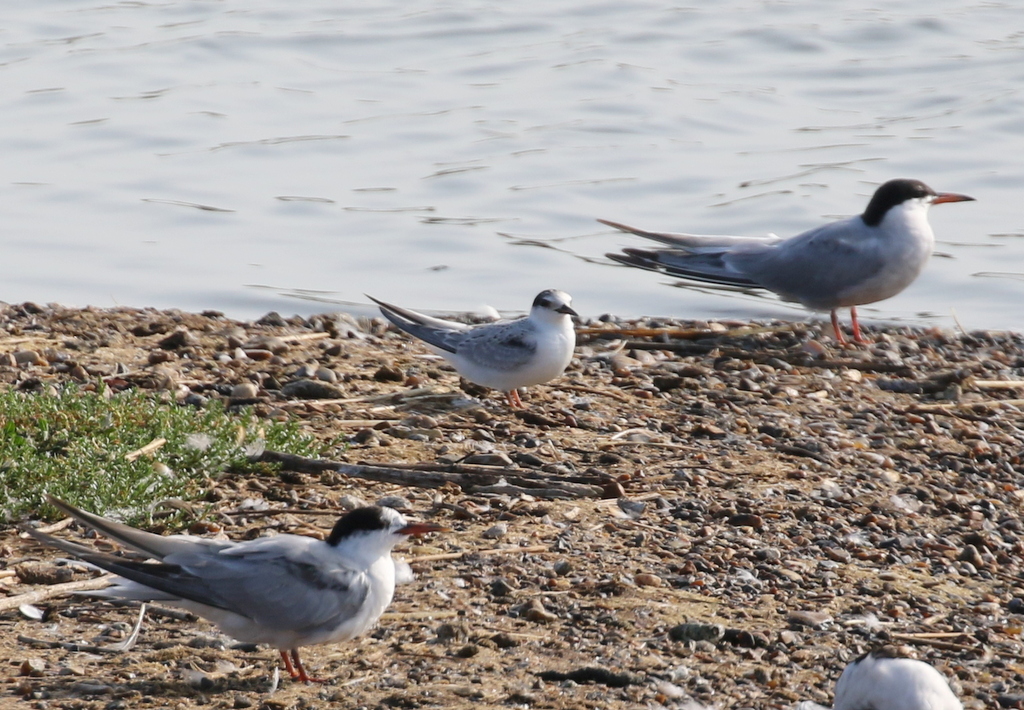 Little Tern – a juvenile in with the Common Terns
Little Tern – a juvenile in with the Common Terns
The Common Redshank were mainly over on the far bank. A smaller group of about twenty or so birds was asleep in the middle of the pit, with the Greylag Geese and Cormorants. Through the scope, we could see they were a mixture of duller, greyer Common Redshanks and paler Spotted Redshanks.
We made our way round to the viewing screen at the southern end of the pit next. On our way there, we could see lots of Knot still circling out over the Wash, possibly disturbed by the Peregrine. The tide was still high and there was no exposed mud, but perhaps some of them had chosen to try to roost with some of the larger waders out on the saltmarsh today.
From down at the viewing screen, we could see there were fewer smaller waders at this end of the pit today. There were lots of Oystercatchers, with a single Avocet in with them, plus quite a few Black-tailed Godwits roosting here. Some geese flew in over the bank and landed on the water, with several Canada Geese amongst the Greylags. A couple of Egyptian Geese were sleeping on the bank. A family of Moorhen walked around the gravel bank along the edge to one side of the hide.
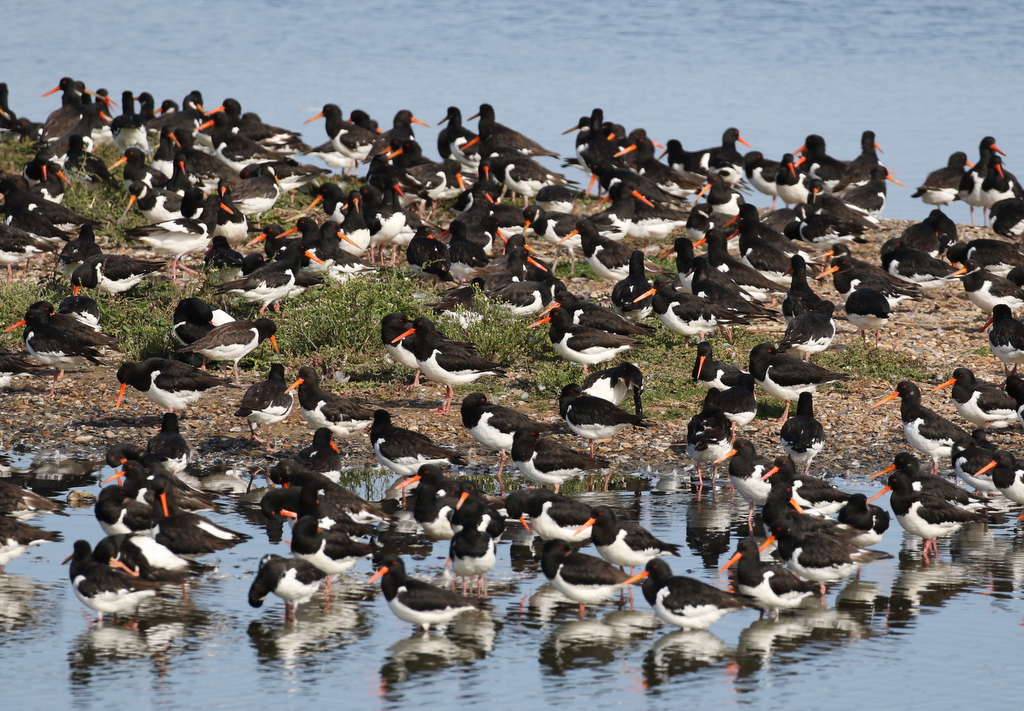 Oystercatchers – roosting at the southern end of the pit
Oystercatchers – roosting at the southern end of the pit
By now, it was already a good time after high tide, so we walked back out to look at the Wash again. The water was already receding, and there was lots of exposed mud. Quite a few waders were already out there, but they were still very jumpy. When they all flew up, we could see a Peregrine flying across behind them, carrying something in talons. It had clearly been more successful out here then over the pit earlier. A young Marsh Harrier set off after it, clearly with one eye on its prey, but the Peregrine seemed unperturbed and continued away across the saltmarsh.
It was a lovely warm morning and there was quite a bit of raptor activity here today. A Common Buzzard circled up over the mud, chased by a Kestrel. Over across the other side of the saltmarsh, by the seawall, a Marsh Harrier was tussling with a Red Kite, the latter circling lazily and avoiding the Marsh Harrier effortlessly.
A Common Sandpiper flew past again, along the channel in front of us, and a Greenshank flew the other way, calling. The rest of the waders were very slow coming off the pits today. As we stood here for a few minutes, several lines of Oystercatchers flew past and landed back out on the mud, and a few small groups of Dunlin flew out to join them. Time was getting on now, so we decided to make our way back to the car.
We headed round to Titchwell next. The overflow car park was busy today, perhaps not a great surprise given the lovely weather. After our early start, it was time for an early lunch. As we sat eating in the picnic area, a Chiffchaff was calling in the sallows. A couple of Common Darters were basking on one of the benches and several Migrants Hawkers and Speckled Woods were flying around in the sunshine.
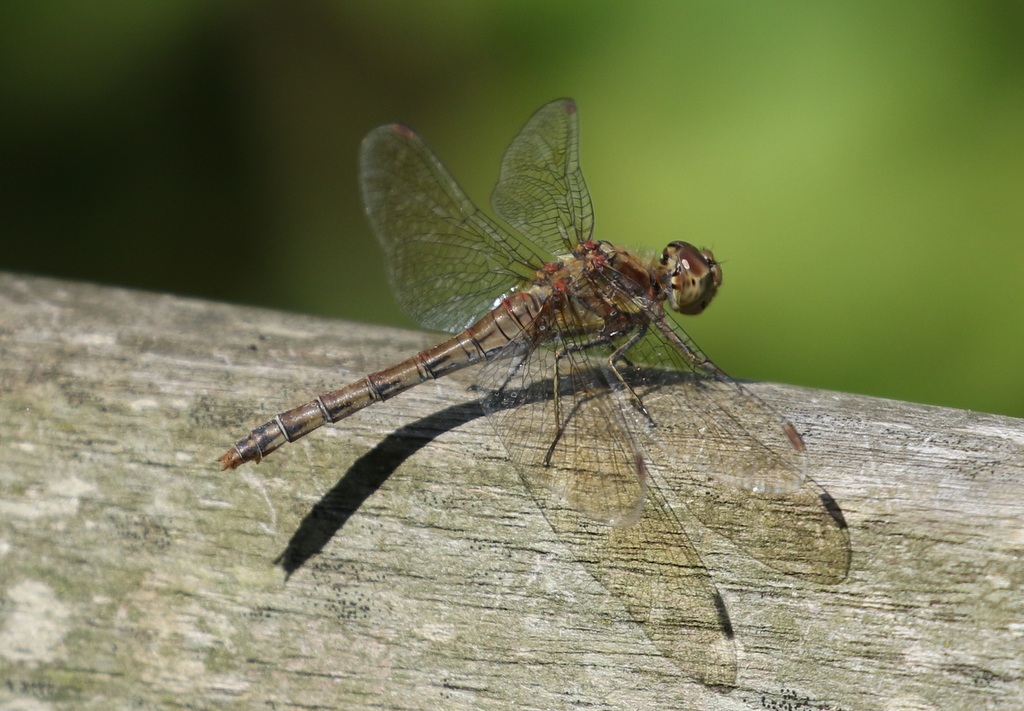 Common Darter – basking on a bench in the picnic area
Common Darter – basking on a bench in the picnic area
After lunch, we headed out to explore the reserve. We had a quick look at the feeders by the visitor centre, which held a nice selection of finches and tits. Out along the main path, a Blackcap was calling in the bushes down in the ditch.
As we passed the Thornham grazing marsh, we heard a Bearded Tit calling in the reeds, but despite waiting for a minute or so, it didn’t show itself. The reedbed pool was quiet, but as we scanned over the reeds, we spotted a group of Spoonbills flying up from the back of the freshmarsh beyond. We could see their long outstretched necks as they flew, their bills held straight out in front. They flew towards us, eight of them, before three peeled off and headed out over the saltmarsh towards Thornham Harbour and the other five circled round and dropped back onto the freshmarsh.
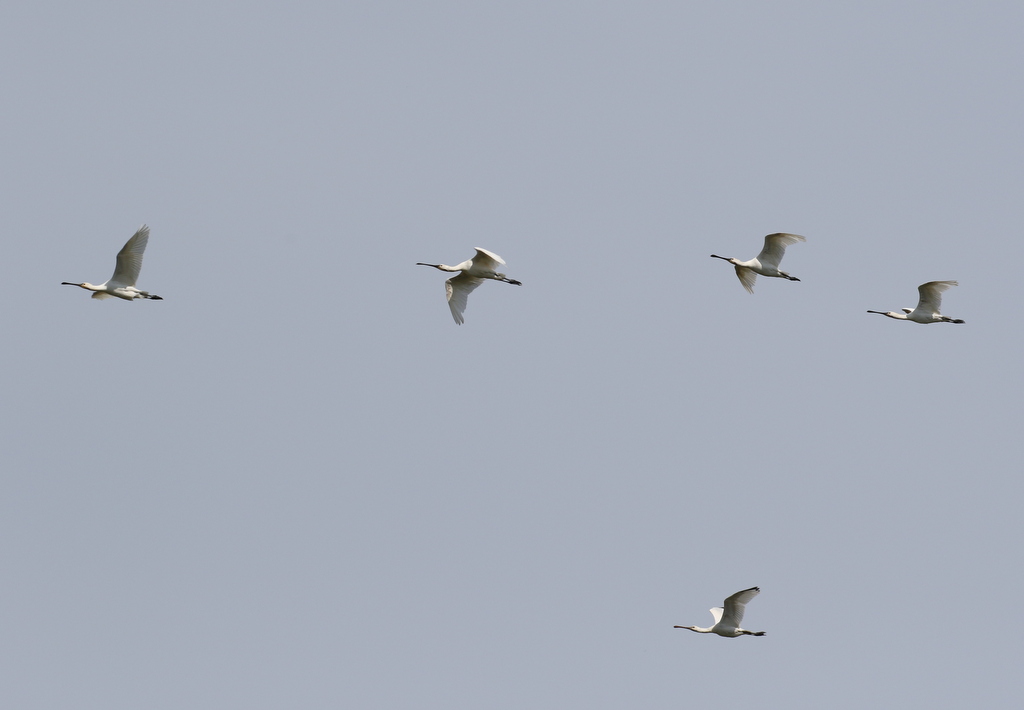 Spoonbills – five of the eight which flew up from the freshmarsh
Spoonbills – five of the eight which flew up from the freshmarsh
There were plenty of waders out on the freshmarsh from Island Hide. Several Ruff were feeding on the mud right in front of the hide, a mixture of tawny-brown juveniles and grey/white adults now in non-breeding plumage. A juvenile female (traditionally called a Reeve) was much smaller than the juvenile males around it. Further over we could see lots of Avocet and Black-tailed Godwits, some of the latter still sporting the remnants of their rusty orange summer plumage.
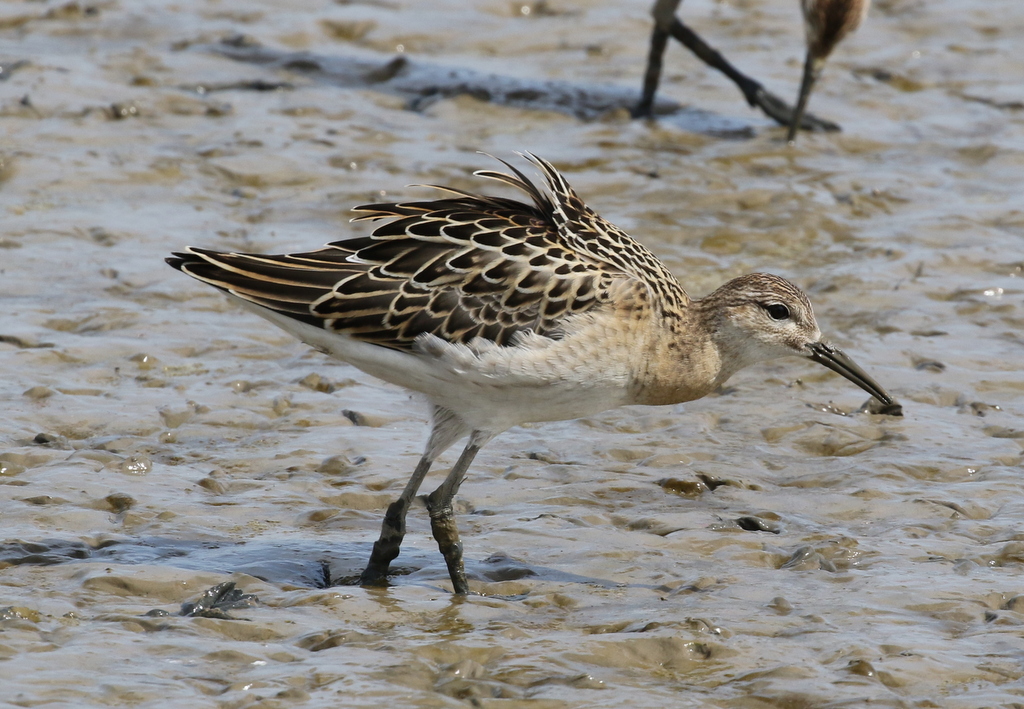 Ruff – a tawny brown juvenile
Ruff – a tawny brown juvenile
Looking more carefully around the islands, we found a Common Sandpiper feeding along the edge of the mud, running along, bobbing up and down. Two Ringed Plover were feeding on the same island, close by. Over towards the main bank, a smaller juvenile Little Ringed Plover was bathing. A Common Snipe was feeding on the edge of the reeds, probing its long bill deep into the wet mud.
When we heard a Greenshank calling, we looked across to see it flying in over the main bank. It flew towards us and dropped in on the edge of the mud in front of the hide briefly. It helpfully stayed just long enough for us to have a good look at it, then flew off again calling.
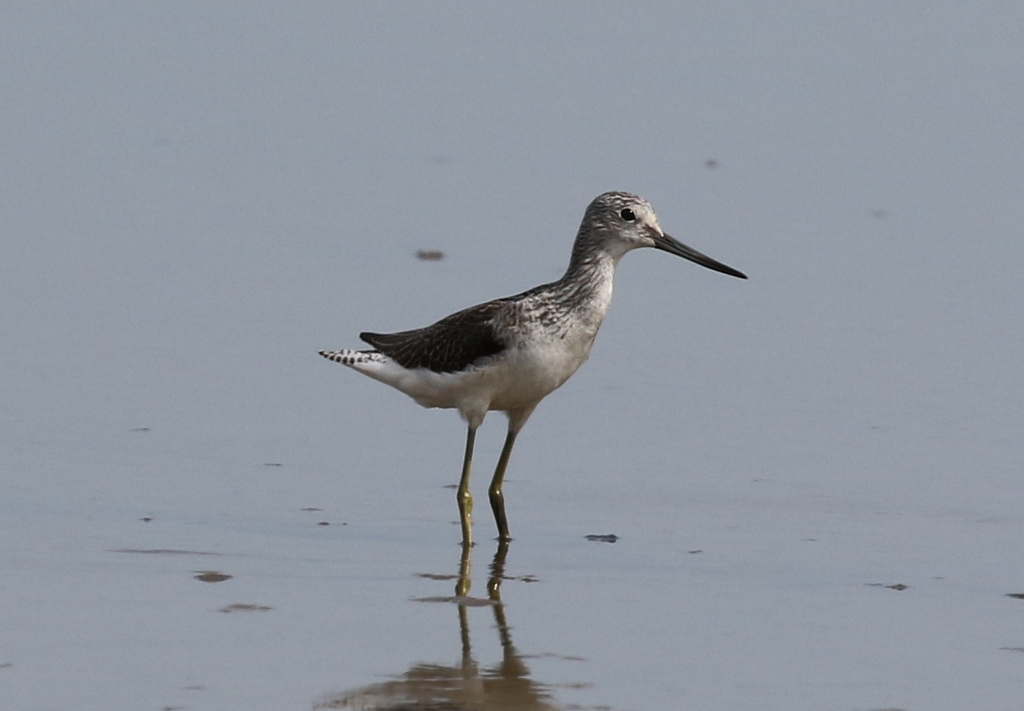 Greenshank – dropped down on the edge of the mud briefly
Greenshank – dropped down on the edge of the mud briefly
The ducks are all in dull brown eclipse plumage at the moment. There are quite a few Teal back here now and we did see a couple of Shoveler too.
Bearded Tit was a particular request for the day, but at first all we had was the occasional ‘pinging’ call coming from the reeds. Each time we heard them, we looked over and eventually found a single Bearded Tit working its way low down along the edge of the reeds. We got it in the scope, but it was a little distant. Then two more Bearded Tits called from the reeds just across from the hide and we managed to get good views of these in the scope as they hopped around just beyond the edge of the mud.
With the Bearded Tits in the bag, we made our way round to Parrinder Hide. There had been a male Grey-headed Wagtail here for the last couple of days, the northern Scandinavian race of Yellow Wagtail, but we were told it could be elusive. There were lots of wagtails out on the islands, plenty of Pied Wagtails and at least four regular Yellow Wagtails, but no sign of the one we were looking for.
We decided to continue out to the beach. As we walked along the path beside the Volunteer Marsh, a Black-tailed Godwit was feeding on the edge of the channel below us, giving great views. We stopped briefly to scan the channel at the far end and found a couple of Grey Plover feeding on the mud, looking stunning still in breeding plumage, with jet black faces and bellies.
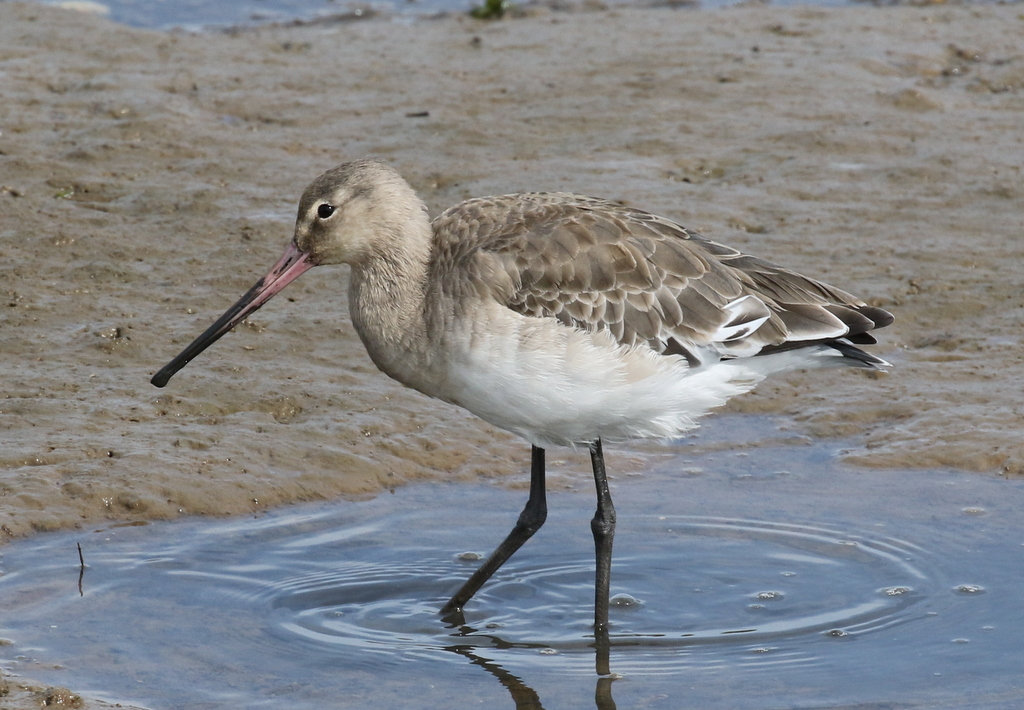 Black-tailed Godwit – feeding on the Volunteer Marsh by the main path
Black-tailed Godwit – feeding on the Volunteer Marsh by the main path
The beach was very busy today. Several people were out on the mussel beds and two dogs were running around on there too, so there were comparatively fewer waders than usual. There were still plenty of Oystercatchers and a few Curlew, plus a couple of little groups of Turnstone.
There was not much to see out to sea today either. A quick scan produced two Great Crested Grebes out on the water. So we decided to start walking back.
When we got back to the freshmarsh, we stopped for another scan. Looking over at the island in front of Parrinder Hide, we could still see loads of wagtails in the vegetation. As we scanned across a dark slate-grey head appeared in the leaves, followed by a bright yellow throat and breast – the Grey-headed Wagtail!
It was hard to see, as it was running around and kept disappearing into the low vegetation on the island, but eventually everyone got a really good look at the Grey-headed Wagtail. A striking bird. The Little Ringed Plover we had seen earlier was also showing very well now, on the mud just below the path..
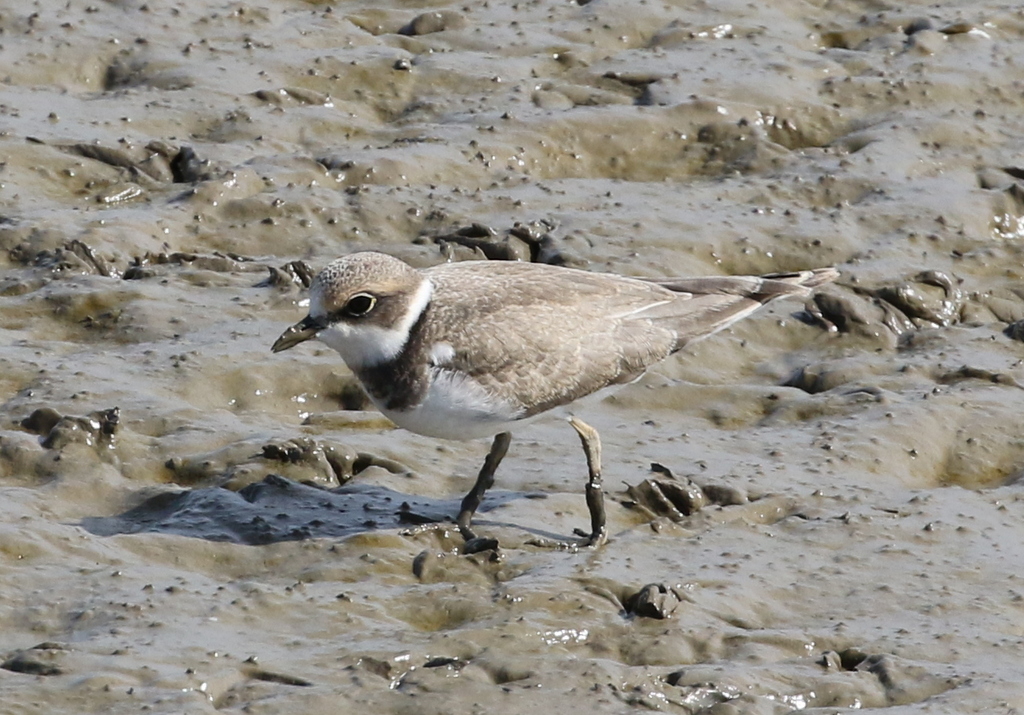 Little Ringed Plover – a juvenile, feeding on the mud below the main path
Little Ringed Plover – a juvenile, feeding on the mud below the main path
It was hot and sunny now, so it was nice to get back to the shade of the trees. Unfortunately, it was time to call it a day and head back to the car. We didn’t have time to explore the whole reserve today, after our busy morning up on the Wash, but we had seen a few nice birds. It had been a stunning spectacle today, a morning well spent and well worth the early start!
















